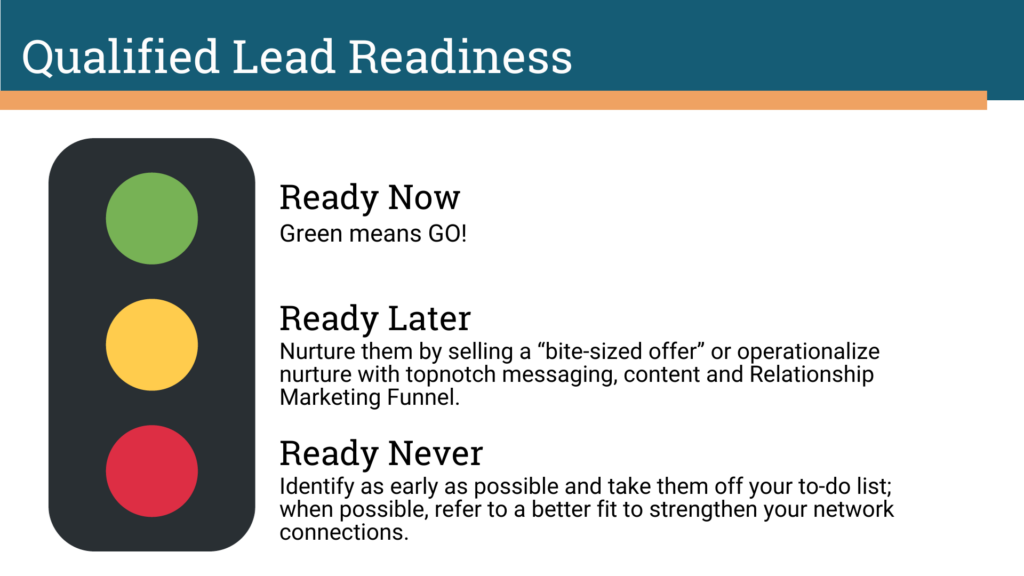How to Identify Qualified Leads Effectively
Posted on October 19th, 2023 to Uncategorized
Are you facing obstacles in acquiring genuinely qualified leads for your business?
Whether your pipeline looks thin, you struggle to close existing leads, or clients opt for quick fixes over comprehensive solutions, the common thread often leads back to distinguishing between unqualified and qualified leads.
And what’s even more intriguing is that even those contacts who seem like the perfect fit, the so-called ‘ideal clients,’ may not necessarily qualify as genuine leads.
If the previous sentences made you think twice, I’ve got you.
In this blog post, I’ll walk you through the process of identifying and nurturing truly qualified leads, ensuring you don’t waste your valuable time, energy, and profitability on the wrong prospects.
Let’s get into it.
Qualified Leads vs Unqualified Leads
This may seem obvious but let’s revisit the definition of a qualified and unqualified lead, as my definition comes with qualifiers.
An unqualified lead is a buyer at a company that fits your client avatar criteria, yet they are still unqualified.
A qualified lead is a buyer at a company that fits your client avatar criteria AND has shown intent to buy WITH the budget, authority, need and timeliness to be worth your time.
That last part is the key, and we’ll go deep into the B.A.N.T. framework (that’s Budget, Authority, Need, Timeliness) later in the post.
To illustrate why this is so important, let’s look at a client story (no names have been included to protect the innocent!).
Meet the superstar executive coach who failed to do the work upfront.
The Executive Coach & Consultant to Fortune 500 Teams
This client is who the Fortune 500 companies call when there’s infighting and discord at the C-Suite level.
Her specialty is to come in, mediate and right the ship.
In the past few months, she found herself in an unfamiliar place — staring down a calendar of open appointments and little revenue projected.
Given her extensive network of contacts, she boldly reached out to schedule calls with her ideal client avatar — many of whom love her work — to generate some leads for her 5-figure consulting package.
The calls went well, but here’s what happened:
Only three companies agreed to do a one-off workshop at 5,500, not her 35K package. The rest fell off the map.
My client didn’t do anything wrong by reaching out and booking these calls. And while the interactions resulted in some business, it was far from the scope of work she wanted and needed to close.
I share this story because it clearly shows the consequences of not diligently qualifying your leads as soon as possible: smaller deal sizes, massive loss of time, energy and confidence, and ghosting.
You don’t want this, and I don’t want it for you!
So, in the next section, we’ll move on to how to qualify your lead and avoid disappointment.
You can work with those dreamy clients and close big deals; the following sections will help you do it.
How Do You Know They’re Qualified? B.A.N.T.
If you’re unfamiliar with the BANT framework, it’s a set of criteria salespeople use to qualify leads and assess the likelihood of closing a deal.
By evaluating these four criteria, you can prioritize your efforts and focus on prospects more likely to convert into customers.
It helps in qualifying leads effectively and efficiently, saving time and resources.
Let’s break down each aspect of B.A.N.T. and how to use it to qualify your leads:
Budget: This refers to the prospect’s budget or financial resources. Does this lead and their company have the financial capacity and willingness to purchase at the price you’re offering?
Authority: This pertains to identifying the individual or individuals within the prospect’s organization who have the power to make purchasing decisions.
You’ve heard me talk about Champions, but the Decision Makers make the final call. How likely is your proposal to make it through the layers of approval to get the final sign-off?
Need: Understanding the prospect’s needs involves uncovering their specific pain points, challenges, and tensions that your product or service can address. This is about determining whether there’s a genuine need for what you’re offering.
Timely: This refers to the prospect’s purchasing decision timeline. Knowing if the prospect has a sense of urgency and when they intend to take action is essential. How painful is this problem for them and the company? How soon do they want to solve it?
Now that we’ve defined these criteria, let’s take it further and look at how to know whether your lead is ready to sign on the dotted line at the time of the proposal.
Are They Ready For Your Proposal?
Once you get the lead, there’s even more to determine. And if you’re thinking, MORE?
The sales process takes time and effort, my friends!
Next, you have to assess their readiness. I like to think of them in three buckets:
Ready Now
Ready Now leads are our favorite – Green means GO!
Ready Later
Ready Later leads get tricker for us founders because you’ve met and nurtured them, but they’re not there yet. Nurture them by selling a bite-sized offer or operationalize nurture with topnotch consistent messaging, valuable content and a relationship marketing funnel.
Ready Never
Ready Never leads are self-explanatory, but figuring that out is hard. Lean into BANT to figure out what’s going on with them.
Identify as early as possible and take them off your prospect list. But you can salvage the time and effort you’ve put into determining their readiness by referring them to a better fit. This is a win-win because you provide a solid connection and help out a contact of your own.
Once you’ve assessed their readiness and considered the Budget, Authority, Need, and Timeliness, you are in the ideal position to know whether your lead is qualified and worth giving more time and energy to the sales process.

Qualified vs Unqualified Leads: Points to Remember
In conclusion, when it comes to your business leads, it’s essential to remember these key takeaways.
Your biggest challenge often stems from dealing with unqualified leads versus qualified ones.
Just because a potential contact appears to be an “ideal client” or you have a relationship with them doesn’t necessarily make them a qualified lead.
Instead, use the B.A.N.T. criteria – Budget, Authority, Need, and Timeliness – to assess their status.
Neglecting lead qualification can result in smaller deals, wasted time and energy, and even being left in the dark.
To avoid these pitfalls, use the B.A.N.T. framework and categorize your leads as Ready Now, Ready Later, or Ready Never.
By adhering to these principles, you can save valuable resources and ensure your efforts are focused on genuinely qualified leads, ultimately boosting your business’s profitability and success.






